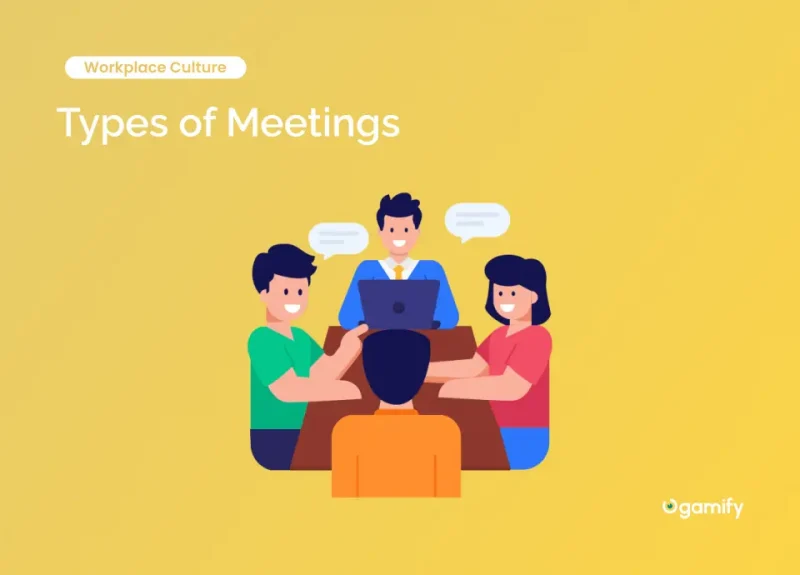In today’s fast-paced business environment, effective communication and collaboration within a team are crucial for success. Meetings serve as a valuable platform for exchanging ideas, making decisions, and fostering teamwork. However, not all meetings are created equal. Various types of meetings cater to different objectives and situations. In this article, we will explore 12 different types of meetings that you can conduct with your teams to enhance productivity and achieve desired outcomes.
What is a Team Meeting?
A team meeting is a scheduled gathering of individuals within a team to discuss and collaborate on shared goals, projects, or tasks. It serves as a platform for team members to communicate, exchange information, provide updates, make decisions, and address any challenges or issues. Team meetings promote collaboration, alignment, and effective coordination among team members, fostering a sense of unity and shared responsibility towards achieving collective objectives.

How to Set Up Team Meeting?
Setting up a team meeting involves several key steps to ensure its effectiveness and productivity:
- Define the Purpose: Clearly identify the purpose and objective of the meeting. Determine whether it is for project updates, problem-solving, decision-making, or any other specific goal.
- Determine the Agenda: Create a detailed agenda outlining the topics to be discussed, including specific items or tasks that need attention. Share the agenda with the team in advance to allow them to come prepared.
- Select a Suitable Date and Time: Consider the availability and time zones of team members when scheduling the meeting. Aim for a time that accommodates everyone as much as possible.
- Choose the Right Communication Platform: Select a communication platform that works well for your team, whether it’s a video conferencing tool, collaboration software, or a combination of different tools.
- Send Meeting Invitations: Send meeting invitations to team members, providing essential details such as the date, time, duration, and meeting platform. Include the agenda and any relevant documents or materials for pre-meeting preparation.
- Prepare Relevant Materials: Gather any necessary documents, presentations, or visuals that will be discussed during the meeting. Share them with the team beforehand to allow for a thorough review.
- Facilitate Active Participation: Encourage active participation by creating a supportive and inclusive environment. Allow team members to voice their opinions, ask questions, and contribute to the discussion.
- Keep the Meeting on Track: As the meeting progresses, ensure that discussions stay focused on the agenda items. Manage the time effectively, and if necessary, table non-urgent topics for future discussions.
- Document Meeting Minutes: Assign someone to take minutes during the meeting, summarizing key points, decisions, and action items. Share the minutes with the team after the meeting for reference and accountability.
- Follow Up on Action Items: After the meeting, ensure that assigned action items are communicated clearly, and deadlines are set. Follow up with team members to track progress and address any challenges.

Types of Team Meetings
In this section, introduce the importance of effective meetings in fostering collaboration, communication, and achieving organizational goals.
- Daily Check-In Meetings: Daily check-in meetings provide a platform for team members to share updates, align goals, and promote transparency within the team.
- Brainstorming Sessions: Brainstorming sessions foster creativity and innovation by encouraging open discussion and generating a wide range of ideas to solve problems or develop new concepts.
- Project Update Meetings: Project update meetings allow teams to track progress, discuss challenges, and ensure everyone is aware of the current status of the project.
- Problem-Solving Meetings: Problem-solving meetings involve collaborative efforts to analyze and address challenges, finding effective solutions to overcome obstacles.

- Performance Evaluation Meetings: Performance evaluation meetings provide a platform for feedback, goal setting, and recognizing achievements, contributing to individual and team growth.
- Decision-Making Meetings: Decision-making meetings facilitate discussions, evaluation of options, and consensus-building to make informed choices that impact the organization.
- Client or Stakeholder Meetings: Client or stakeholder meetings involve engaging with external parties to understand their needs, align expectations, and build strong relationships for successful project outcomes.
- One-on-One Meetings: One-on-one meetings offer personalized interactions for coaching, mentoring, and addressing individual concerns, supporting professional development.

- Departmental Meetings: Departmental meetings enhance coordination, communication, and information sharing within a specific department, promoting a cohesive organizational culture.
- Remote or Virtual Meetings: Remote or virtual meetings provide flexibility, global accessibility, and cost-effectiveness, enabling teams to connect and collaborate regardless of location.
- Town Hall Meetings: Town hall meetings encourage open communication, address concerns, and involve the entire team in decision-making processes, fostering transparency and engagement.
- Wrap-Up Meetings: Wrap-up meetings serve as a platform to summarize key discussions, review action items, and ensure everyone is aligned before concluding a project or task.
Conclusion
In conclusion, effective meetings are essential for fostering collaboration, enhancing communication, and achieving desired outcomes within teams. By understanding the various types of meetings available, you can tailor your approach to ensure productive and engaging interactions. Remember to consider the objectives, participants, and context when selecting the appropriate meeting type. Embrace the power of meetings to nurture teamwork, innovation, and success within your organization.
FAQ
How long should a team meeting typically last?
The duration of a team meeting can vary depending on the purpose and agenda. Generally, it is recommended to keep meetings concise and focused, aiming for a duration of 30 minutes to an hour. However, complex or extensive discussions may require longer meetings.
What if some team members cannot attend the scheduled meeting?
If some team members cannot attend the scheduled meeting, consider recording the session or providing meeting minutes to keep them informed. Alternatively, reschedule the meeting to accommodate everyone’s availability, if feasible.
How can I ensure active participation from all team members during the meeting?
To encourage active participation, create a supportive environment where everyone feels comfortable sharing their thoughts and ideas. Establish clear meeting norms, invite input from all participants, and consider using interactive techniques such as brainstorming or round-robin discussions.
Is it necessary to have an agenda for every team meeting?
Yes, having an agenda is essential for effective team meetings. It helps keep the meeting focused, ensures that important topics are addressed, and allows participants to come prepared. An agenda sets clear expectations and helps maximize productivity.
How can I manage time effectively during a team meeting?
To manage time effectively, designate specific time slots for each agenda item and stick to them. Allocate more time for critical discussions and consider setting a time limit for individual contributions. Additionally, encourage brevity and concise communication to ensure efficient use of meeting time.

